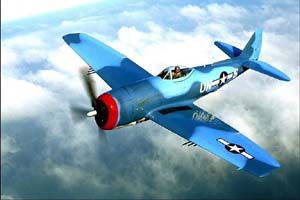Republic P-47N Thunderbolt
U.S. Fighter
 |
The Ghost Squadron's P-47N Thunderbolt. Image source: The Confederate Air Force Ghost Squadron CD-ROM produced by Corel. Photos by Bill Crump. |
Developed as a successor to the earlier P-43, the Republic P-47 Thunderbolt was designed to use the most powerful engine then available, the Pratt & Whitney R-2800, which in early versions gave 2,000 hp. In addition, the Thunderbolt had a turbo-supercharger mounted in the rear of the fuselage, which allowed the engine to produce greater power at high altitudes. The resulting design was huge, compared to contemporary fighters such as the P-39 and P-40, and the plane’s nickname quickly became the "Jug".
The XP-47B first flew on 6 May, 1941, and achieved 412 mph, which resulted in an order for the P-47B by the USAAF. By November 1942, the three squadrons of the 56th Fighter Group were operational, and they joined the 8th Air Force in England in January 1942. Thunderbolts flew their first mission on 8 April, 1943, providing escort to B-17s.
The P-47C was the first model to feature a dropable fuel tank under the belly or wings of the aircraft, thus allowing the Thunderbolt to escort the bombers further into enemy territory. About 600 of the C models were produced in 1943. The next, and best known version of the Thunderbolt was the P-47D, which had 2,300 hp and provision for two 150-gallon drop tanks, allowing even greater long range escort missions.
Early versions of the D model continued with the original canopy style and a high, ridged fuselage, often called a "razorback". To increase the pilot’s rear view, the P-47D-25 introduced a clear "teardrop" all-around view canopy, with a cut down rear fuselage. In addition, racks under the wings could hold ten air to ground rockets, which added extra punch as the Thunderbolt became more used in the ground attack role in 1944 and 1945.
The final version of the Thunderbolt to see action in World War II was the P-47N, which was designed for very long range operations in the Pacific, escorting B-29s. This model could carry up to 1,266 gallons of fuel, for a range of 2,350 miles. Some N models were sent to the 56th Fighter Group in Europe and along with M models were painted in various green-grey or blue-grey schemes (borrowed from British photo-recon schemes) in an attempt to close with high flying German fighters without being seen at a great distance.
Over 15,600 Thunderbolts were built, and in one and a third million hours of combat flying, less than 0.7 per cent were lost, an exceptionally low figure, especially for a fighter.
Specifications
One Pilot One Pratt & Whitney R-2800-77 Engine Curtiss Electric Propeller Eight .50 caliber Machine Guns Max. Speed 467 mph @ 32,500 feet |
Initial climb rate 2,770 ft/min Length 36' 1" Max. Weight 20,700 lbs Normal Range 800 miles |